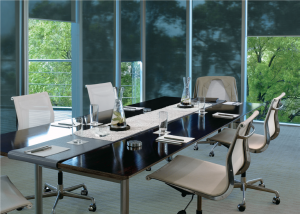75% of window coverings remain in the same position every day in a bid to reduce glare.
Glass has become one of the defining factors of modern architectural design, with floor-to-ceiling windows now a go-to in commercial and residential design. Chosen not only for its sleek and clean appearance, it also increases the level of natural light within an interior. It’s not a feature expected to diminish in popularity either, with architects incorporating glass into their designs continuing to be a growing trend. However, while it may have the desired effect from a design perspective, utilizing glass comes with further design considerations for interiors, namely an increase in sun glare, UV radiation and heat coming into the building.
In this sense, while glass may look aesthetically pleasing on the exterior, it can actually have negative effects on an interior, such as excess heat and fabric fading from UV radiation. In a bid to counteract these negative effects, performance fabrics – specifically when used in window coverings – provide functional qualities such as durability, UV protection, comfort and thermo-regulation. In this whitepaper, we look at how specifying high-quality performance fabrics can have a positive impact on design by combatting the issues that come with utilizing glass in buildings.
When considering window coverings, it is advised to specify a performance fabric that has the ability to reduce the sun’s glare while maintaining views through when in use.
Key Considerations when Specifying Window Coverings
To ensure that the benefits of glass in buildings are not compromised in both residential and commercial spaces, the following considerations should be taken into account when specifying window coverings.
The Great Outdoors: Maintaining View Through
As well as providing privacy, the use of window coverings is required to reduce sun glare – especially in Australia, with some cities receiving up to 286 days of sunshine a year. However, while the use of window coverings may reduce sun glare, which can affect TV and computer screens, as well as shiny surfaces within the home, it does mean that the original design of a building can be compromised, not to mention the benefits of having large windows are lost.
When in use, traditional window coverings that completely block views to the outdoors can prevent a building’s location from being fully enjoyed from indoors, as well as natural light entering. Studies have shown that access to natural light and outside views in the home and office are important for our physical and psychological health, with further research indicating that 75% of window coverings remain in the same position every day in a bid to reduce glare.
When considering window coverings, it is advised to specify a performance fabric that has the ability to reduce the sun’s glare while also maintaining views through when in use. This will ensure that the design can be fully enjoyed while providing comfort to those using the space.
Fading Fabrics: UV and IR Protection
With sunlight and natural light comes ultraviolet (UV) radiation, which causes damage faster than visible light. Then there’s infrared radiation that heats materials causing textiles, inks, dyes and pigments to fade and discolor. Studies have shown that UV radiation is the single largest contributing factor in the fading of fabrics, carpets and other furnishings.
UV radiation that enters through glass and windows can therefore have long-term negative impacts on a well-planned project with carefully-selected furniture, artwork, rugs and fabrics. When specifying window coverings, choosing a performance fabric that blocks as much UV radiation as possible will ensure that interior furnishings are not compromised and negatively affected over time.
Keep it Cool: Space Saving through Heat Reduction
Not only does the use of glass in design contribute to an increase in sun glare, but it also adds extra heat to an interior. Studies have shown that 76% of sunlight falling on standard double pane windows enters to become heat.
When specifying window coverings, it is advised to opt for a performance fabric that reduces the amount of heat from the sun entering a room, allowing the space to be fully utilized as intended. With performance fabrics, heat and light are controlled, ensuring that residents are not experiencing disruptive heat at the window.
The use of SilverScreen in window coverings reflects up to 85% of solar energy before it turns to heat.
Click here to view the full white paper document.

